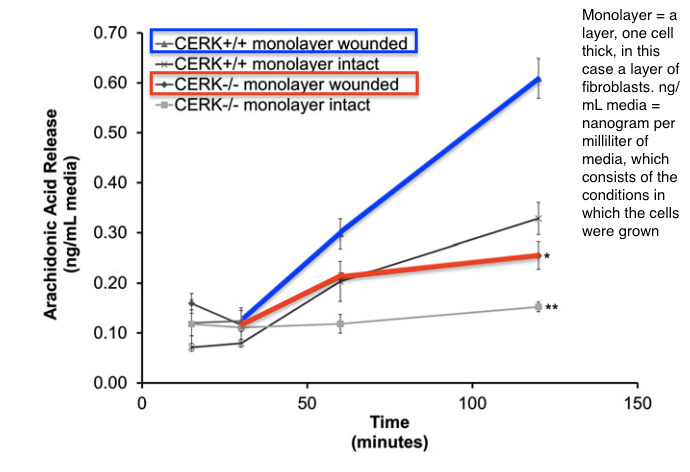Mouse embryonic fibroblasts were used from both CERK-null and wild-type mice. These fibroblasts were either freshly extracted or immortalized to ensure that they may be used efficiently in culture. The fibroblasts were seeded on 100 mm tissue culture plates. The conditions in which they were seeded includes the presence of DMEM, Dulbecco's Modified Eagle Medium, which is a medium that supports the growth of many cells such as mouse embryonic fibroblasts. In addition to this medium, 10% FBS (growth supplement) and 2% penicillin/streptomycin (bacterial contamination prevention) were added. The cells were subjected to standard incubation conditions overnight with the presence of [3H] arachidonic acid. Trituum-3, labeled as [3H], is an isotope of hydrogen, and it is a radioactive compound that may be used to label the arachidonic acid for further use in the scintillation counter. The monolayer was incubated with this compound and so that it could be integrated in the fibroblasts' membranes. The monolayer was then rested in 2% serum and 2% penicillin/streptomycin as previously mentioned. The arachidonic acid release was measured after mechanically induced trauma was exerted on the monolayer by a pipette tip. This release
consists of the cytosolic phospholipase A2 cleaving the arachidonic acid off of the fibroblasts' membrane. The arachidonic acid then movies outside the cell and the eicosanoids made will bind to cell membrane receptors on the fibroblasts to initiate internal pathways that lead to fibroblasts' migration. The measurement was taken by scintillation, a process of which a radiation detector uses flashes of light to count molecules.
The arachidonic acid release was found to be significantly higher in wounded CERK wild-type fibroblasts rather than ablated. As shown in the figure, AA release was measured in nanograms per milliliter of medium. Although the wounded CERK-/- fibroblasts showed an increase in arachidonic acid release, it was not a significant increase. The wounded CERK+/+ fibroblasts did show a significant increase in the release of arachidonic acid. In regard to cytosolic phospholipase A2, there was a possibility that expression of this enzyme may play a role in the decrease of arachidonic release shown by CERK-/- fibroblasts. Wijesinghe et. al. 2014 analyzed the expression levels of this enzyme of both the CERK-null fibroblasts and the wild-type ones. The expression levels of these enzymes did not show any significant differences, which means that the decrease in arachidonic acid release levels due to absence of ceramide kinase did not affect the expression of cytosolic phospholipase A2.
